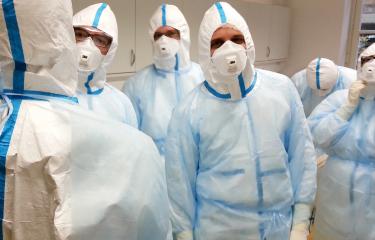Teams at the Institut Pasteur and the French National Center for Scientific Research (CNRS) have succeeded in developing a tool that uses DNA microarray technology which can detect the presence of a virus or a known bacterium, or one of their emerging variants, within 24 hours. When the influenza A (H1N1) virus emerged in April 2009, the research teams showed that this microarray could detect and identify the new variant using clinical samples. This tool could be used in the future in the event of an epidemic outbreak, so that the pathogenic agent(s) responsible could be identified as a matter of urgency. This would then help the health authorities in their management of the epidemic.
Press release
Paris, january 20, 2010
Researchers from the Institut Pasteur and the CNRS working in the Oncogenic Virus Epidemiology and Pathophysiology Unit, directed by Antoine Gessain, and in the Urgent Response to Biological Threats, directed by Jean-Claude Manuguerra, have worked on a large-scale collaborative project at the Institut Pasteur and have developed a DNA microarray which can detect and identify a virus or bacterium from a very broad range of infectious agents in complex clinical situations.
In terms of the influenza A (H1N1) epidemic which started in April 2009, the technique was able to show quickly – within 24 hours – whether the viral variant was present in clinical samples. It is therefore able to cover a broad viral genetic diversity, can discriminate with great accuracy, even when a mixture of viruses is present, and can remove the need for conventional sequencing techniques. The microarray also made it possible to determine the geographical area and the circulation period of many seasonal and swine-origin H1N1 viruses that were tested, as well as the origin – whether avian or swine – of the different segments of the variant (H1N1) virus.
A DNA microarray is a solid surface which has specific nucleic probes spatially arranged on the surface. When the probes are in contact with the test sample and if they are complementary to the viral or bacterial (DNA or RNA) nucleic acids, they bind closely to it. Using powerful means of molecular amplification and bioinformatic analysis tools, the signal that is produced enables the nucleic acids to be identified, even if there are only small quantities present.
The microarray that has been developed by the researchers therefore makes it possible to test simultaneously for a number of target genes (determined beforehand) for one or more pathogenic agents, and this can be done in a single operation. Although these tools were not designed for diagnostic purposes on an individual level, they can still be used in epidemics that may arise in the future because they can be used to identify quickly the pathogenic agent responsible. This would help the health authorities in their decision making, particularly in terms of how to treat patients.
The next phase in the development of this tool will be to produce a new generation of microarrays which will have a greater capacity to identify the viral agents involved, in human pathologies as well as in animal pathologies.
__
These works received a financial support from the Fondation Total.
Source
High-density resequencing DNA microarrays in public health emergencies, Nature Biotechnology, online, January 10, 2010
Nicolas Berthet (1), India Leclercq (2,3), Amélie Dublineau (2), Sayuri Shigematsu (2), Ana Maria Burguière (2), Claudia Filippone (1), Antoine Gessain (1), Jean-Claude Manuguerra (2).
(1) Institut Pasteur, Oncogenic Virus Epidemiology and Pathophysiology Unit, CNRS URA3015, Paris France.
(2) Institut Pasteur, Urgent Response to Biological Threats (CIBU) Unit, Paris, France.
(3) Université Paris Diderot, Paris, France.
Contact presse
Institut Pasteur Press Office
Nadine Peyrolo or Marion Doucet - + 33(0)1 45 68 89 28 - presse@pasteur.fr




